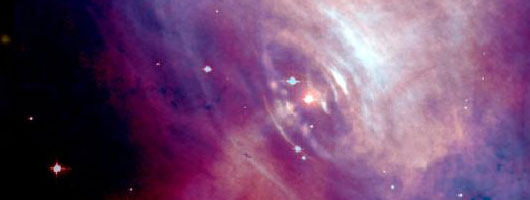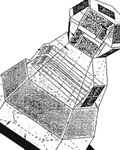HEXIS
High Energy X-ray Imaging Survey

The High Energy X-ray Imaging Survey (HEXIS) proposal for a Medium-class Explorer Mission was submitted in response to NASA AO-95-OSS-02 in 1995. HEXIS was not selected for development.
 We proposed a 3-100 keV hard X-ray continuous all-sky imaging spectrometer (5-10 times more sensitive than the ASM on XTE and 30 times more sensitive than BATSE) combined with a hard X-ray imaging telescope (5-10 times more sensitive than HEXTE or OSSE) for a MIDEX mission. This mission, the High Energy X-ray Imaging Survey, or HEXIS, will generate a hard X-ray, flux-limited, all-sky survey a factor of 100 deeper than the HEAO-1 A-4 13-180 keV survey, 15 times deeper than the HEAO-1 A-1 0.25-25 keV survey and the HEAO-1 A-2 2-10 keV extragalactic survey. HEXIS will continuously image the entire hard X-ray sky with 25 arcminute spatial resolution, will provide spectra with 5 times better energy resolution at 60 keV than any scintillator mission, and in addition will provide finer images with of selected portions of the sky 5 times deeper than XTE and with 5 times better spatial resolution than SIGMA. This survey will yield spectra and identifications of thousands extragalactic objects, and many hundreds of galactic sources. The HEAO-1 A-4 13-180 keV survey 1 degree resolution and 13 mCrab sensitivity detected 65 galactic and 7 extragalactic sources, and the HEXIS 1/2 degree resolution and 0.1 mCrab sensitivity will yield 4000 extragalactic objects and 1-5 thousand galactic sources. The galactic content of the survey will include all objects brighter than 5 x 10^34 ergs/s anywhere in the galaxy, above 10^35$ ergs/s in the galactic bulge, and above 10% of the solar luminosity within a kiloparsec. Thus, all black holes >1% of Cyg X-1, all binary X-ray pulsars >1% of Her X-1, and all microquasars >0.1% of 1915+105 are available to be studied as a class, and not as prototype objects. One can also focus on the various spectral components, such as reflection and reprocessing of the primary flux, from many hundreds of Active Galactic Nuclei (AGN) to expand and refine our understanding of the processes present and the interrelationship of the various phenomenological types. In addition the AGN data from HEXIS can be used to address the question of the origin of the diffuse hard X-ray flux by providing the ranges in spectral shapes for a multitude of extragalactic objects. Furthermore, the all-sky continuous imager will detect and locate transient hard X-ray sources, and will observe XXX gamma-ray bursts per year and locate them to <10 square arcminutes (a thousand times smaller than the best BATSE derived error boxes).
We proposed a 3-100 keV hard X-ray continuous all-sky imaging spectrometer (5-10 times more sensitive than the ASM on XTE and 30 times more sensitive than BATSE) combined with a hard X-ray imaging telescope (5-10 times more sensitive than HEXTE or OSSE) for a MIDEX mission. This mission, the High Energy X-ray Imaging Survey, or HEXIS, will generate a hard X-ray, flux-limited, all-sky survey a factor of 100 deeper than the HEAO-1 A-4 13-180 keV survey, 15 times deeper than the HEAO-1 A-1 0.25-25 keV survey and the HEAO-1 A-2 2-10 keV extragalactic survey. HEXIS will continuously image the entire hard X-ray sky with 25 arcminute spatial resolution, will provide spectra with 5 times better energy resolution at 60 keV than any scintillator mission, and in addition will provide finer images with of selected portions of the sky 5 times deeper than XTE and with 5 times better spatial resolution than SIGMA. This survey will yield spectra and identifications of thousands extragalactic objects, and many hundreds of galactic sources. The HEAO-1 A-4 13-180 keV survey 1 degree resolution and 13 mCrab sensitivity detected 65 galactic and 7 extragalactic sources, and the HEXIS 1/2 degree resolution and 0.1 mCrab sensitivity will yield 4000 extragalactic objects and 1-5 thousand galactic sources. The galactic content of the survey will include all objects brighter than 5 x 10^34 ergs/s anywhere in the galaxy, above 10^35$ ergs/s in the galactic bulge, and above 10% of the solar luminosity within a kiloparsec. Thus, all black holes >1% of Cyg X-1, all binary X-ray pulsars >1% of Her X-1, and all microquasars >0.1% of 1915+105 are available to be studied as a class, and not as prototype objects. One can also focus on the various spectral components, such as reflection and reprocessing of the primary flux, from many hundreds of Active Galactic Nuclei (AGN) to expand and refine our understanding of the processes present and the interrelationship of the various phenomenological types. In addition the AGN data from HEXIS can be used to address the question of the origin of the diffuse hard X-ray flux by providing the ranges in spectral shapes for a multitude of extragalactic objects. Furthermore, the all-sky continuous imager will detect and locate transient hard X-ray sources, and will observe XXX gamma-ray bursts per year and locate them to <10 square arcminutes (a thousand times smaller than the best BATSE derived error boxes).
This unprecedented database from an instrument that views ALL OF THE SKY ALL OF THE TIME will contain images and detailed spectra of ALL the hard X-ray sources in the sky brighter than 0.1 mCrab on timescales of fractions of a day to months, depending on source strength. Most previous (and future) missions only provide snapshots of such data and for small fractions of the sky. For instance, if XTE's pointed instruments view 100 different sources per year for 3 years, they will have only sampled less than 1% of the sky! From this survey will come a series of evermore detailed releases of the publicly available Complete Inventory of the Hard X-ray Sky. The HEXIS science team will remove the instruments' signature from the data and present catalogs consisting of images of the sky in various energy bands from 3-100 keV plus information on the location, identification, time variability, and spectra of thousands of hard X-ray emitting astrophysical objects. This unprecedented on-line database will join the ROSAT All-Sky Survey, IRAS Sky Survey, EUVE, the VLA, Palomar, etc. to strengthen the astrophysics multiwavelength database. The Complete Inventory of the Hard X-ray Sky will be a vital building block in NASA's plan for ``... making multi-wavelength analyses possible and thus, ushering in the era of `panchromatic' astrophysics'' (Report of the X-ray Astronomy Program Working Group 1994).
The addition of the >10 keV hard X-ray band to the growing list of comprehensive astrophysical surveys is of crucial astrophysical importance, since obscuration by intervening Galactic gas and dust does not limit the view of the galaxy or beyond, and because hard X-ray emission frequently originates close to the primary energy release. Extending observations of cosmic X-ray sources from the conventional 2-10 keV range, where in techniques using focusing X-ray optics are readily applied, into the higher energy ranges is a central objective of high energy astrophysics. It is in the tens of keV regime where the production by non-thermal processes becomes dominant over thermal emission in many sources, such as binary X-ray sources, supernovae remnants, active galactic nuclei and clusters of galaxies. Indeed, this whole regime has been studied only with limited sensitivity and angular resolution thus far, and many studies for future space missions have indicated the important new knowledge of astrophysical phenomena likely to be obtained with modern instruments operating in this range.
The HEXIS mission instruments will utilize the room temperature semiconductor CdZnTe in mosaiced arrays of position sensitive devices in conjunction with coded masks. The All-Sky Continuous Imager (ASCI) contains 12 individual telescopes, each with ~400 square centimeters of detector area, 1 steradian (60 degrees x 60 degrees) field of view, and 24 arcminute angular resolution. At 20 keV ASCI has a detection sensitivity of 1.5 mCrab in a day and <0.09 mCrab in a year, and continuously views the entire non-occulted sky. The Narrow Field Pointed Imager (NFPI) will have ~1600 square centimeters of detector area, 0.01 steradian (5 degrees x 5 degrees) field of view, 2.4 arcminute angular resolution, and will be optimized for low background and the high sensitivity. It will image selected fields for times up to ~2 weeks at a sensitivity of ~0.075 mCrab at 20 keV to resolve crowded regions and to provide better data on weak ASCI sources. Each instrument will be based on identical detector modules that provide imaging from 3-100 keV with ~1-2 keV energy resolution throughout the entire energy range. These instruments are made possible by recent advances in relatively large area CdZnTe detectors with fine spatial resolution (100's of microns) and low power, high density read out systems. The instruments' sensitivities over the 3-100 keV energy range guarantee overlap and complementarity at lower energies with ROSAT, ASCA, AXAF, and XMM missions, and at the same time provide links to CGRO and INTEGRAL observations at higher energies.
The ASCI will be the source of the Complete Inventory of the Hard X-ray Sky -- a complete flux-limited sample of the hard X-ray contents of our Galaxy (~1000 objects) and of the extragalactic sky (~4,000 objects) down to a limiting sensitivity of at 20 keV of 0.1 mCrab, and in addition, will provide alarms and positions for transient phenomena on all timescales from seconds (gamma-ray bursts) to days (X-ray novae). Twelve identical ASCI modules are arranged to view the entire non-occulted sky constantly. The pointed NFPI enhances the science from the HEXIS by providing a deeper imaging capability that will produce more sensitive, higher resolution images of small fields. This will be used for finer imaging of crowded regions and better locations of weak ASCI sources. As a result of the process of taking deeper images, even weaker sources will be detected within the narrow field of view, thereby increasing the overall sample size, and the low background of the NFPI will provide more sensitive spectral studies of weak objects or finer time resolution studies of brighter ones.